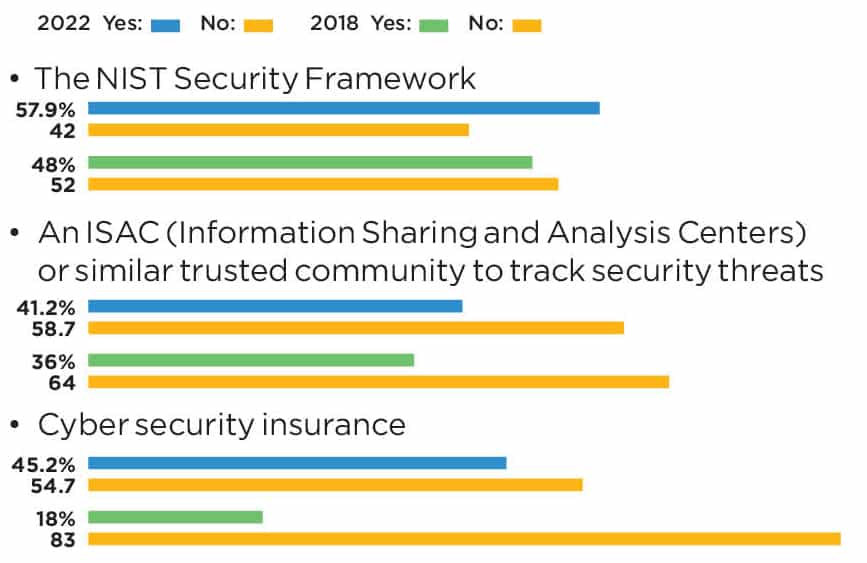Survey: Data Mastery is Slow to Mature but Essential

Manufacturers show some progress with data mastery efforts, but much opportunity for growth exists.

When MLC last fielded its Data Mastery survey in 2021, senior content director Penelope Brown wrote of the results, “Manufacturing data mastery is in its tween years for most enterprises – certainly past its infancy, but still awkward and gawky and not quite fully formed.”
If data mastery was a tween then, the effort is on the final stages before becoming a teenager now. Like a tween, there has been some maturation but also some regression in how companies are accessing and using data and analytics. Likewise, companies can see dramatic development in specific areas of data utilization, but each organization seems to mature at its own pace while encountering a wide array of challenges and pursuing various desired outcomes and focus areas.
Why is progress slow? To further the tween metaphor: perhaps it is growing pains. More than one-third of respondents tell us that the volume of data they’re collecting has at least doubled. Nearly 20% say the amount of data has at least tripled. Before this exponential growth came into play, companies were already dealing with an uphill climb to verify and analyze data. Given this rapid growth – like in tween years – there’s bound to be some awkwardness and slower progress.
Still, it is clear from the 2023 MLC Data Mastery and Analytics survey that mastering manufacturing data will be essential to future competitiveness. Presently, 91.1% of respondents report that data has allowed for more accurate or timely decisions, both of which are essential to overcome the pressures that businesses face now and those they will face as their data mastery skills continue to mature.
Read on for key findings and selected graphs from the 2023 Data Mastery and Analytics survey.
Part 1: Data Strategy and Governance
The majority of respondents have a formal data plan and guidelines in place, but there has been little change since the last time we fielded this survey in 2021. Currently, 56.5% of respondents say they have a corporate-wide plan, strategy, or formal guidelines for how data is collected and organized. This number sat at 55% in 2021.
Q: Does your company have a corporate-wide plan, strategy, or formal guidelines for how data is collected and organized across the enterprise, including manufacturing operations? (select one)

For those with a formal corporate-wide data strategy, nearly all (90.5%) see at least some alignment to overall business strategy, but only 52.4% say it aligns entirely or very closely.
Q: If your company has a corporate-wide plan, strategy, or formal guideline for how data is collected and organized, how closely do you feel this data strategy is aligned to your company’s overall business strategy? (select one)

Measuring data’s value is still elusive to many organizations. However, there’s been increases in assigning monetary value and measuring revenues of data-driven services in the past two years. In fact, 22.6% of respondents now say they measure the value of data in monetary terms compared to 4% in 2021. Meanwhile, 12.1% say they measure data’s value by revenues of data-driven services compared to 3% in 2021.
Q: How do you measure the value of the data in your organization? (select all that apply)

Manufacturers see a slight positive shift in their ability to collect the right data the business needs. In 2021, 16% of survey respondents ranked their company as highly able to collect the right data. In the latest survey, that number has climbed over 20%. On the low end of the spectrum there was only minimal change moving from 26% in 2021 to 26.8% in 2023.
Q: How would you rank your company’s ability to collect the right data the business needs from your manufacturing operations? (select one)

Part 2: Data Collection, Use, and Analysis
The ability to analyze manufacturing operations data is an opportunity for growth. Just over half of respondents report their company is moderately able to analyze the data, while 30.4% say they have low competency.
Q: How would you rank your company’s ability to analyze the data from your manufacturing operations? (select one)

Shop floor systems and ERPs remain the primary data sources. In fact, shop floor systems use increased from 79% in 2021 to 88.4% in 2023, while ERP systems increased from 77% in 2021 to 83.9% in 2023. Quality control systems, equipment maintenance systems, supply chain systems, and robotics systems saw similar increases since the previous survey, but product development systems fell 16 percentage points to 22.3%.
Q: What are the primary systems that generate your manufacturing data today? (select all that apply)

The survey revealed that there is considerable room for growth in real-time data collection. Less than half of respondents report their company’s data is comprised of 51% or more real-time or near real time data.
Q: What proportion of the data you collect today is real-time or near real time, not batch or historical? (select one)

In the past two years, companies are collecting more manufacturing data. Eighty percent report they’ve seen at least some increase in the amount of data collected. Meanwhile, more than one-third of respondents say the amount of data has at least doubled in that time.
Q: What has been the percentage increase in the amount of manufacturing data you are now collecting compared to two years ago? (select one)

Looking ahead at the operational focus for data projects in two years, respondents foresee a varying shift from manufacture, quality, maintenance, inventory, logistics, and assembly to process control, supply chain, track and trace, inspection, security/data protection, and tooling.
Q: What are your primary areas of operational focus for data projects today and what do you expect the primary focus will be in 2 years’ time? (select top three)

Microsoft Excel remains the reigning champion of data analysis tools. In 2021, 71% of survey respondents reported that Excel was in their data analysis toolkit. That number rose slightly in 2023 to 72.3%. Statistical analysis programs of standard BI systems jumped from 47% in 2021 to 60.7% in 2023. This moved it from the fourth most used tool in 2021 to second place this year. Meanwhile, manufacturers are increasingly outsourcing analytics, with 24.1% utilizing external analytics partners this year compared to 14% in 2021. Somewhat surprising, the use of AI systems has decreased from 48% (when taking in-house, cloud and external AI partners in aggregate) to 41% in 2023.
Q: What systems do you use to analyze the manufacturing data you collect? (select all that apply)

Respondents’ companies are evenly split when asked about verifying the accuracy and quality of raw data. About 46% report they have a process while approximately 45% say they do not. In the 2021 survey, for comparison, 49% reported they had a process while 46% reported they did not.
Q: Does your company have a process to verify the accuracy and/or quality of the raw data before decisions are made on it? (select one)

Part 3: Outcomes and Challenges
Increased data access has resulted in a variety of operational improvements. Leading the charge are cost reductions, productivity improvements, efficiency, quality, and uptime – all of which were cited as an improvement seen by 50% or more of survey respondents.
Q: In what ways has increased access to manufacturing data helped you to improve your manufacturing operations? (select all that apply)

Cost reductions are the primary motivator for new manufacturing data projects now, and this is expected to remain constant in two years. In fact, 65% of 2021 survey respondents anticipated that reduced costs would be a key business outcome objective this time around – a number that tracks closely with the 67.6% that listed reduced costs on this year’s survey. While reduce costs is anticipated to lead the charge again in 2025, the number is anticipated to decrease by 10 percentage points in that time. The biggest upward movers by 2025 are expected to be improved production speed, integrated processes, improved supplier network effectiveness, improved security, and monetizing data.
Q: What are your key business outcome objectives for embarking on new manufacturing data projects today and what do you expect the outcome objectives will be in 2 years’ time? (select top three)

Data improves accuracy and speed of decisions. Half report that decisions have been more accurate and 40% point to more timely decisions. Only 6.3% of respondents report that there has been no change in their company’s decision-making because of data availability, while less than 2% of respondents, respectively, cite slower or worse decisions as the most prevalent way that data has affected their decisions.
Q: What is the most prevalent way that data has affected your company’s decision-making? (select one)
Survey respondents report that many challenges or obstacles are hindering their company from making more data-driven decisions. The leading challenges – each cited by 39-49% of respondents – are extracting data from legacy systems, lack of skills to analyze data effectively, and integration of data from different sources.
Q: What are the most important challenges or obstacles hindering your organization from making more data-driven decisions? (select top three)

Three out of four respondents report that data mastery is essential to their business competitiveness in the future. This 75%/25% split remains consistent with responses to the 2021 survey.
Q: Looking forward, how important will mastering manufacturing data become to your competitiveness as a future business? (select one)

About the author:

Jeff Puma is Content Director for the Manufacturing Leadership Council
Survey development was led by the MLC editorial team with input from the MLC’s Board of Governors.
Survey: Smarter Factories Are on the Way
Manufacturing Leadership Journal content and MLC resources are exclusively available to MLC members. Please sign up for an account or log in to view this content.
Survey: Sustainability Momentum Surges Dramatically
Manufacturing Leadership Journal content and MLC resources are exclusively available to MLC members. Please sign up for an account or log in to view this content.
Survey: More Expect M4.0 Tech Adoption to Increase
Manufacturing Leadership Journal content and MLC resources are exclusively available to MLC members. Please sign up for an account or log in to view this content.
SURVEY: Manufacturers Get Tough on Cybersecurity

More companies are taking a disciplined approach to dealing with the growing threat of cyber attacks, a new MLC survey finds.

The message has been received.
After years of mounting warnings about the risks of being hacked or worse and now faced with a sharply rising number of cyber attacks in the industry, manufacturers have taken concrete steps to fortify their defenses and protect themselves against what is widely assumed will be an even larger threat in the years ahead.
More manufacturers than ever before have put in place formal cybersecurity plans in their companies to deal with threats and attacks. They are significantly increasing their levels of confidence that they have the internal expertise in place to deal with cybersecurity issues. And a majority of companies now have dedicated cybersecurity budgets, including provisions for cyber insurance, and are providing cyber awareness and technical training to their employees.
These are some of the most important findings of the Manufacturing Leadership Council’s new survey on cybersecurity. More than 160 companies expressed their views on cybersecurity strategy in their organizations, whether they have been attacked and what the nature of those attacks were, what measures they have adopted to defend themselves, and how the growing problem of cybersecurity may be affecting their adoption of Manufacturing 4.0 and their transition to the digital model of manufacturing.
Formal Planning Takes Off
A sea change in how seriously manufacturers consider the cyber threat has occurred at the strategy level. Just four years ago, according to MLC’s 2018 cyber survey, barely one-third of manufacturers had devised and adopted formal cybersecurity plans that encompassed their plant floors. Today, the new MLC survey shows that nearly 62% have put such plans in place (Chart 1).
The more serious attitude is directly related to the perceived consequences of cyber attacks. When asked how important cybersecurity is as a business issue, 83% of survey respondents said it is of high importance, compared with 66% saying so in 2018. Moreover, 64% said this year that business disruption is the most significant cybersecurity-related risk to their companies, compared with 58% in 2018. Interestingly, very few fear equipment or product damage from cyber attacks and only 18% this year are worried about the theft of proprietary information (Charts 2,3).

The advent of connected business ecosystems will test current cyber strategies.
Bolstered by the greater focus on formal planning and now regular awareness and technical training for employees on cybersecurity, a growing number of manufacturers feel confident that they have the internal expertise to deal with manufacturing-related cyber issues. This year, nearly 40% of survey respondents said they had a high level of confidence about their internal expertise, compared with 25% saying so in 2018. Another 46% assessed their confidence levels as moderate this year (Chart 4).
More Attacks Expected
Even as better cybersecurity strategies are put in place and confidence in internal capabilities to deal with threats and attacks grows, an overwhelmingly large number of manufacturers expect more attacks in the year ahead, a perception that is no doubt driving much of the greater emphasis on defensive measures.
This year, nearly 79% of survey respondents said they expected more attacks in the next year, compared with 64% expressing that feeling in 2018 about 2019 (Chart 8). The three most cited reasons for this expectation are more criminal activity; greater connectivity in their operations, particularly with Internet of Things technologies; and more cyber terrorism (Chart 9). Of least concern: insider- or supply chain-originated attacks. Phishing, malware, and ransomware are the most prevalent methods of cyber attack cited by respondents overall.
When asked to assess the cyber battlefield and its most important points of vulnerability, survey respondents painted an interesting picture of where conflict is most likely to play out.
Mobile devices, e-mail servers, and laptop computers were cited by respondents as having the highest level of cyber vulnerability – not plant floor equipment or plant floor control systems. Looked at from a business function or activity perspective, a similar dynamic – vulnerabilities caused by external connections – was revealed in the survey data. Social media networks, partner and distribution networks, and supply chain networks were the most cited points of vulnerability – not plant floor networks, design and innovation networks, or field service operations. In addition, respondents said their best protected systems are their ERP and MES systems.

More manufacturers than ever have adopted formal cybersecurity plans.
What these findings suggest is that, as manufacturers go about forging so-called business ecosystems of partners, suppliers, and customers that are increasingly digitally connected, they will have to extend existing cyber strategies and tactics or even create new ones to protect these networks in the future. This is perhaps the next frontier in cybersecurity.
Manufacturers are starting to decode these signals. When asked in this year’s survey whether they have introduced or changed cybersecurity requirements for external partners and vendors with which they share data, 48% said that they had. In addition, 70% said the increase in remote working spurred by the pandemic has caused them to make adjustments to their cyber policies.
The Effects on M4.0
Based on their perception that cyber attacks will increase in the years ahead, more than half of survey respondents expressed concern that cybersecurity issues could affect the speed and scope of adoption of Manufacturing 4.0. Fourteen percent said cyber could be a major obstacle in the next five years, with another 40% describing it as “an issue of concern”. A significant percentage, 43%, consider cyber to be just part of doing business in an M4.0 world (Chart 13).
As they devise their defenses, manufacturers are relying more on internal mechanisms, such as corporate best practices and policies and closer collaboration between IT and OT teams, rather than law enforcement or government regulations (Chart 10).
Moreover, more are taking advantage of publicly available approaches, such as the NIST Security Framework, to underpin their strategies. This year, almost 58% of survey respondents said they have adopted the NIST framework, up from 48% in 2018. In addition, there has been a sharp rise in those subscribing to cyber insurance – 45% today, compared with only 18% in 2018 (Chart 12).
All in all, manufacturers have been moving on multiple fronts to combat the growing cyber problem. The challenge for industrial companies going forward will be to try to stay one step ahead as the number and sophistication of attacks increase even as they expand their digital networks outside the four walls of their business. M
Part 1: CYBERSECURITY STRATEGY AND ORGANIZATION
1. Strong Majority Now Have Formal Cyber Strategies
Q: How would you characterize your company’s approach to dealing with manufacturing cybersecurity?

2 Business Issue Concerns Rise
Q: How important is cybersecurity as a business issue to your company, in terms of securely interconnecting systems or exchanging operating data within, or across, your manufacturing sites and partner companies?

3 Business Disruption Still Leads Cyber Risks
Q: What is the most significant cybersecurity-related risk to your company’s manufacturing operations?

4 Internal Expertise Confidence Rises Sharply
Q: What level of confidence do you have that your company has the internal expertise to deal with manufacturing-related cybersecurity issues?

Part 2: MANUFACTURING CYBER ATTACKS AND EVALUATION
5 Nearly Half Have Suffered Cyber Attacks
Q: Have your company’s manufacturing sites ever been a target or a victim of a cyberattack?

6 Nearly Half Also Say that Attacks Have Increased in the Last Year
Q: Have attacks directed at your company’s plant systems and networks increased over the past year?

7 Frequency of Attacks is Significant
Q: How would you characterize the frequency of attacks?

8 More than Three-Quarters Expect More Attacks Ahead
Q: Do you expect your company to experience more attacks in the year ahead than in the past year?

9 Criminal Activity Cited as Top Reason for More Attacks
Q: If yes, what’s driving the increase?

Part 3: POLICIES TO DEAL WITH CYBER ATTACKS
10 Corporate Polices Seen as Best Defense
Q: What do you think will help the most in improving manufacturing cybersecurity in an M4.0 world?

11 Remote Work Has Forced Cyber Policy Changes
Q: Has an increase in remote work required any new changes or adjustments to your cyber policies?

12 NIST Framework is More Widely Adopted
Q: Are you engaged in, or have adopted, any of the following approaches as a way to better protect your company or mitigate cyber risks?

Part 4: THE FUTURE ORGANIZATION
13 Concerns Rise on Effect of Cyber on M4.0
Q: Over the next 5 years, how much of an obstacle will cybersecurity issues be to the speed and scope of adoption of Manufacturing 4.0 technologies and approaches?


About the author:
David R. Brousell is the Co-Founder, Vice President & Executive Director of the Manufacturing Leadership Council.
Survey development was led by David R. Brousell, with input from the MLC editorial team and the MLC’s Board of Governors.
SURVEY: Digital Leadership Playbook Still Work in Progress
Manufacturing Leadership Journal content and MLC resources are exclusively available to MLC members. Please sign up for an account or log in to view this content.
SURVEY: Manufacturing Supply Disruptions to Last Well Into 2023
Manufacturing Leadership Journal content and MLC resources are exclusively available to MLC members. Please sign up for an account or log in to view this content.
SURVEY: Future Outlook: Hazy
Manufacturing Leadership Journal content and MLC resources are exclusively available to MLC members. Please sign up for an account or log in to view this content.
Manufacturing’s Sustainability Challenge: The Race is On
Manufacturing Leadership Journal content and MLC resources are exclusively available to MLC members. Please sign up for an account or log in to view this content.
Pedal to the Metal
Manufacturing Leadership Journal content and MLC resources are exclusively available to MLC members. Please sign up for an account or log in to view this content.

